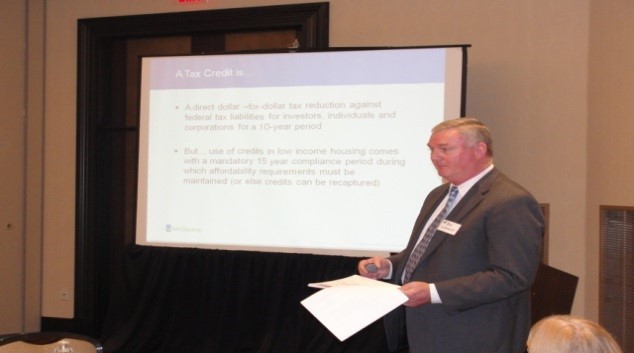Accounting Changes Proposed for the LIHTC Industry Housing Finance
Post on: 17 Июнь, 2015 No Comment

On March 14, the Financial Accounting Standards Board (FASB) considered Issue No. 13-B, Accounting for Investments in Affordable Housing Tax Credits. which was proposed by the Emerging Issues Task Force (EITF) of the FASB. Raymond James Tax Credit Funds led the effort with support from a wide variety of industry stakeholders. The EITF voted to propose new guidance regarding when such investments will qualify for use of the effective-yield method of accounting. On April 17, the FASB released an Exposure Draft of proposed amendments that would modify the conditions that public and private companies are required to meet to elect the use of the effective-yield method of accounting for qualified low-income housing tax credit (LIHTC) investments.
At a Sept. 13 meeting, the EITF deferred approval of revised standards for accounting for LIHTC investments. The EITF could finalize the revised standards at its next meeting in November.
Currently, investors have to meet specific and strict requirements in order to elect use of the effective-yield method, which limits the number of investments that qualify for its use. Investments that fail to meet requirements under the current guidance are required to be accounted for under the equity method or cost method of accounting, as appropriate.
Differing Methods
The presentation of LIHTC investments is significantly different under the effective-yield method as compared to the equity method. Under the equity method, the primary benefit of the investment, the tax credits, is included “below the line” within the income tax provision, while any operating results (typically losses) are included “above the line” in investment performance. Under the effective-yield method, as proposed, tax credits and tax benefits resulting from the operating losses are recognized as they are realized and the initial cost of the investment is amortized to provide a constant effective yield over the period the tax credits and other tax benefits are allocated to the investor. The effective yield is the internal rate of return on the investment, based on the cost of the investment and the probable tax credits and other tax benefits allocated to the investor. Any expected residual value of the investment is excluded from the yield calculation. Under the effective-yield method of accounting, therefore, investment costs are netted with the related tax credits and other tax benefits and presented as a single net tax benefit component of the income tax provision, all “below the line”.
Use of the equity method to account for LIHTC investments has resulted in geography issues on the investor’s income statement as the costs and benefits of the investment are presented in different sections of the income statement. The equity method is more appropriately used to account for investments in which the investor is making an investment in an entity primarily for returns from operations. Most current LIHTC investments do not provide the tax credit investor with any significant participation in the operations, cash flows, or residual values of the underlying real estate, therefore, presenting such an investment as an equity investment in a real estate entity is not an accurate depiction of the substance of the transaction. As a result, use of the equity method is not providing useful information to current and potential investors, creditors, and other users of the financial statements to make rational decisions based on the information presented.
Proposed Amendments
The effective-yield method of accounting leads to a better financial statement presentation for LIHTC investments as it presents the net benefits of the investment in a single, understandable amount. The proposed amendments to the conditions that are required to be met for use of the effective-yield method represent key distinctions between an investment made primarily for the purpose of obtaining tax credits and an investment made for the purpose of investing in an entity with real estate operations. The proposed amendments to the current accounting guidance would allow investors investing in qualified affordable housing projects to utilize the effective-yield method of accounting if all of the following conditions are met:
- It is probable that the tax credits allocable to the investor will be available;
- The investor retains no operational influence over the investment other than protective rights and substantially all of the projected benefits are from tax credits and other tax benefits such as the tax benefits resulting from operating losses;
- The investor’s projected yield based solely on the cash flows from the tax credits and other tax benefits is positive; and,
- The investor is a limited liability investor in the affordable housing project for both legal and tax purposes and the investor’s liability is limited to its capital investment.
Currently, an investor may elect to use the effective-yield method for an affordable housing investment made through a limited partnership only if the investor’s projected yield based solely on the cash flows from the tax credits is positive (other tax benefits are currently not allowable in the calculation of the projected yield, condition (4) above is met, and the availability of the tax credits allocable to the investor is guaranteed by a creditworthy entity.
It is anticipated that more investors will be able to meet the criteria for use of the effective-yield method due to the removal of the guaranty requirement. The industry is confident that more prevalent use of the effective-yield method will make it easier to attract new investors.
Bryan Keller, CPA, is partner-in-charge of one of the nation’s top 50 accounting firms, RubinBrown’s Real Estate Services Group. Keller specializes in affordable housing, HUD finance and audit, Renewable Energy Tax Credits, Low Income Housing Tax Credits, and New Markets Tax Credits. He is a member of the board of directors for the Affordable Housing Tax Credit Coalition, the Urban Land Institute Affordable Housing Council, and the American Institute of Certified Public Accountants Apartment Association.














